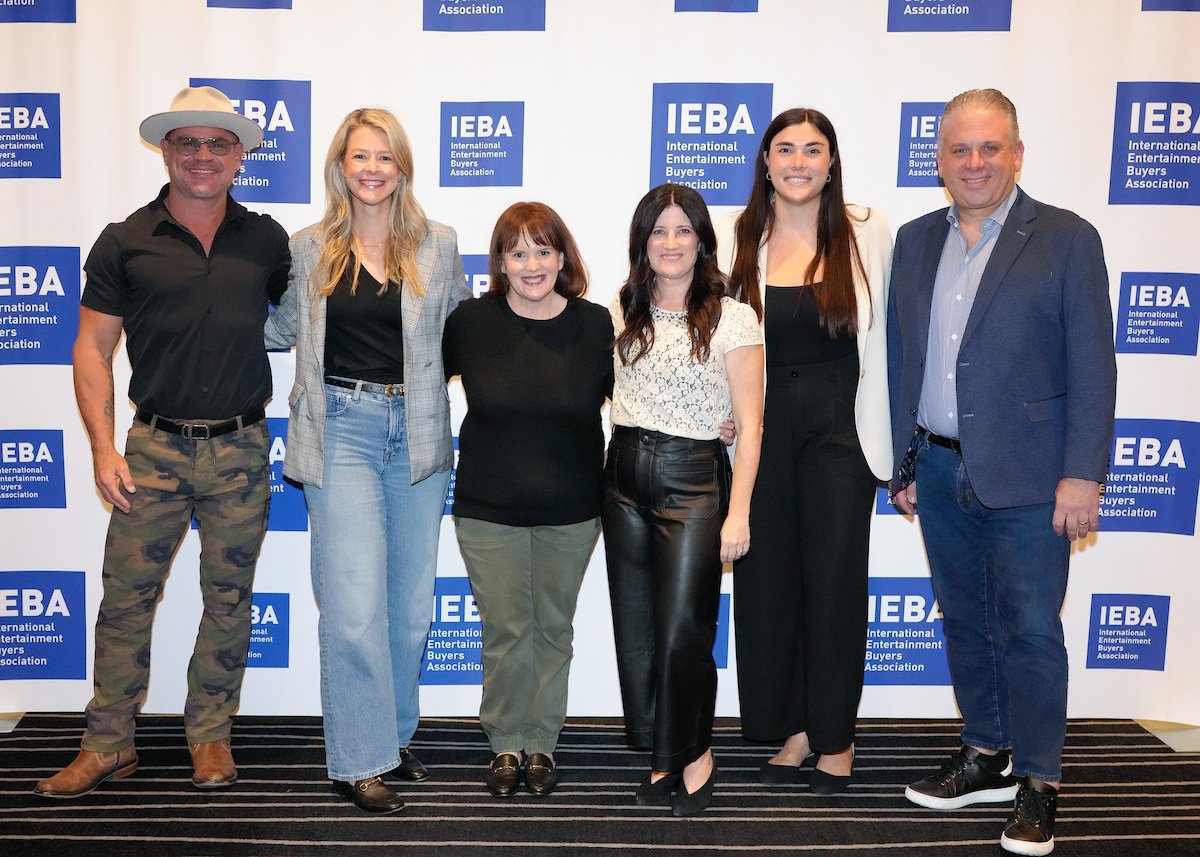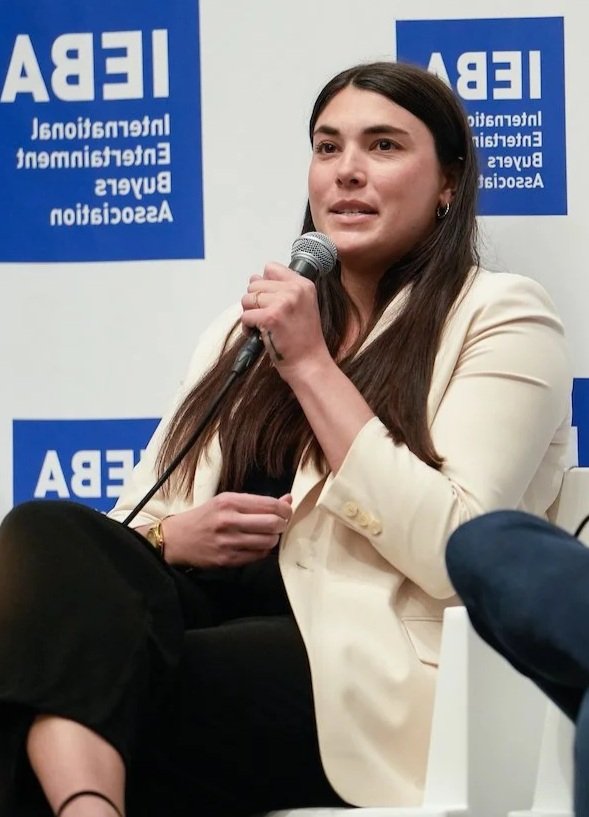FACTS VS. HYPE: WHAT’S REALLY SELLING TICKETS?
Panelists:
Nelson Albareda, Loud and Live
Heidi Feigin, UTA
Tara Klee, AEG
Noël Mirhadi, OVG Theater Alliance
Carrie Murphy, WME
Moderated by: Jim Cressman, Invictus Ent. Group
“Most of us followed our hearts into this business, and then had to figure out how to make a living,” said moderator Jim Cressman as he opened the conversation. Despite constant noise about high guarantees, fees, and soft markets, this session focused on where tickets are moving—and who’s actually responsible for that movement.
Heidi Feigen began with a long-game success story: “My first client 25+ years ago was Sebastian Maniscalco. I’ve watched him go from opener to five sold-out Madison Square Gardens,” she said. “I’m proud that we didn’t rush him into a giant tour deal. We stayed market-by-market, promoter-by-promoter until this last arena run with Live Nation. The key was always: find the right partners in each market and be willing to pivot when things get tough.”
Feigen noted how agency-side tour marketing has changed her world. “We brought in in-house tour marketers who live and breathe the counts,” she said. “We micromanage pricing and flexing because the equation is so complex now. You sell the most tickets when you have thoughtful partners watching those numbers with you every day.”
Noël Mirhadi, who oversees a 24-market theater network for Oak View Group, said her unique vantage point sits between any one venue and any one artist. “When I polled my team about what’s actually selling, the answer was comedy, video-game symphony IP, and family content,” she shared. Nikki Glaser is thriving in 2,500–3,000-cap rooms; Stardew Valley Symphony, developed with John Panell, has “grown into a multi-leg franchise” in the video-game-with-orchestra lane. “And kids/family shows and non-traditional IP are very strong for us right now.”
From the country and podcast side, Carrie Murphy highlighted a different kind of “hard ticket”: live book and podcast tours. “We did Sharon McMahon’s tour last year and the We Can Do Hard Things tour with Glennon Doyle and Abby Wambach this year,” she said. “Those were passion projects, but they completely sold out. People want to be in the same room as the voices they follow on Instagram, TikTok, or in their earbuds. They’re buying shared experience, not just content.”
Murphy framed it simply: “If you’re asking what sells tickets, look at what people need right now—optimism, education, and a reason for a girls’ night out.”
Comedy, Digital Natives & the Power of Niche
“Comedy’s answer to ‘what’s really selling’ is… comedy,” Feigen said bluntly. “But it’s not just stand-up anymore. It’s anything digitally native—podcasts, social media-first personalities, brands that started online.”
She contrasted the old model—HBO special or network sitcom—as the ticketing engine with today’s reality: “Now the prestige feather is HBO, but the ticket driver is Netflix and socials. We have 20–25 arena-level comics on our UTA roster alone. When I started, there were basically no arena comics.”
Still, she warned that viral clips aren’t enough. “Some people are great on TikTok but don’t have a live show. If the material doesn’t translate to 90 minutes onstage, it won’t last,” she said.
What does she look for in an artist who can really sell tickets?
“They must understand social media—or be willing to hire help. You’re your own best promoter now. If you won’t promote yourself, you’re going to struggle.”
“They need to be coachable. If you don’t trust your team’s experience, you’re with the wrong team.”
“They have to work harder than I do. If I want it more than they do, that’s a disaster.”
“Talent still matters,” she said, “but talent alone does not sell tickets. The winners are the ones who connect, communicate, and grind.”
Latin, K-Pop & the Art of Specialization
Nelson Albareda, who runs Miami-based Loud and Live, described his world as “a niche within a niche.” His company promotes Latin touring across the U.S., Latin America, and Europe, plus festivals, venues, and brand partnerships.
He told a favorite “accidental risk” story: after a successful tour, he’d had “a few drinks” at a Person of the Year gala when a manager pitched him a brand-new motivational speaker. “He said, ‘I need $500,000. I’ll give you 20 dates at $25K each.’ I had just made a couple million with his artist, so I wrote the check,” Albareda recalled. “The guy had never done a show, never done a venue.”
His team thought he was crazy—but it worked. “We’ve done about 150 dates with him now, worldwide. He’s a real business. That one bet opened a whole lane for us.”
Post-pandemic, Albareda is laser-focused on discipline in a softer economy. “In the Latin space, our average ticket was $110–$120. Family of four, that’s close to $600 with fees,” he said. “We’re seeing economic pressure, political pressure, and real price resistance.”
He’s boiled his booking philosophy down to three filters:
Strong management. “If the team isn’t capable and organized, we pass.”
Artist who wants to work. “Socials, promotion, media—they have to push the show, not just show up for the check.”
Realistic pricing. “If they want more money, the only lever is raising ticket prices, and the market is saying ‘no’ in a lot of places.”
“We’ve said no to tours where we’ve made money before,” he added. “That’s hard. But some of those artists are coming back after chasing bigger guarantees elsewhere and not liking the results. In Latin especially, local, nuanced marketing matters—how you sell Salt Lake City is not how you sell Miami or Nashville.”
Tara Klee, a global touring buyer at AEG, brought the international and K-pop perspective. A fan since 2013, she now gets to build K-pop and global touring campaigns professionally. “The genre went from ‘no one knows what this is’ to ‘global juggernaut,’” she said. “The question now is how K-pop evolves—K-pop demon hunters, hybrid IP, new formats.”
AEG’s edge, she said, is partnership. “We invest in the relationships—with artists, their teams, and the venues,” Klee noted. “These artists live online. Digital is how fans discover them. Our job is to turn that into a live experience that feels just as special.”
She cited the recent world-record stadium play with Zach Bryan as an example of thinking beyond “it will sell anyway.” “Yes, he’s hot, but we still had to craft the story, the world-record angle, the marketing. You take something that’s already strong and elevate it into a moment.”
Who’s Really Driving the Marketing?
Several panelists agreed the old pattern—promoter presents the marketing plan, artist stays hands-off—is over.
“In 2024, if the artist isn’t talking to fans about the show, we’re leaving money on the table,” Murphy said. Her podcast tours became case studies in direct fan engagement. “Sharon McMahon was literally posting seat maps on Instagram: ‘Here’s what’s left in Chicago. Let’s sell it out.’ And it worked.”
Now, Murphy’s priority is helping artists become consistent narrators of their own story, not just broadcasters of “on sale now.” “We’re asking: how do we stream a flow of content that shows their life and identity, not just the ticket link?” she said. With fast-rising TikTok acts like Dasha, Shaboozey, or Benson Boone, she’s obsessed with one question: “How do we get fans to connect the viral song to the artist’s face and brand so they’ll leave their house and buy a ticket?”
Feigen echoed that tour and artist marketing now sit closer to the artist than the promoter. “A lot of comics will say, ‘Why do I need promoters? I promote myself,’” she joked. “The truth is, you need both. But if you’re not promoting yourself, you’re in trouble.”
Noël added that even traditional performing arts centers are changing behavior. “For years, PACs locked in a season 12–18 months out and mailed a brochure. Now they have to leave space and move faster—more like Live Nation or AEG—so they can hold dates for acts that blow up on a six-month timeline.”
Pricing, Scaling & the All-In Ticket Era
When the conversation turned to pricing, Feigen didn’t sugarcoat it. “This is a sore spot,” she said. “We’re all dealing with economic reality and all-in pricing.”
Her “insurance policy” for artists is smart scaling. “You can still have a strong top ticket, but don’t overexpose the house at that price,” she advised. “Use tiers. Let the data tell you how many tickets belong in each band. And be ready to flex early, not three days before the show.”
For comedy, she uses 30%+ first-weekend sales as a healthy on-sale benchmark, but she looks past the topline. “If the sales are going front-to-back, you’re probably OK. If it’s back-to-front, you’ve got a problem,” she said. “Platinum pricing is one of my favorite tools when used correctly—you can adjust without overtly ‘discounting.’”
The all-in era has fundamentally shifted strategy. “I won’t put a show on sale without seeing the true all-in price,” Feigen said. “We think we’ve priced a ticket at X, then we see the out-the-door price and go, ‘Oh no.’ That’s where the psychological line is for fans—$80 might be fine, $100 might not be.”
She also prefers reinvestment over reduction when possible. “I’d rather call management and say, ‘Let’s put $5K of your guarantee into marketing. If it works, you make it back in the backend—and your brand in that market grows.’ I almost never start with, ‘Let’s cut the guarantee.’”
Murphy sees similar patterns in country. “We’re seeing more last-minute buying,” she said, “but you can’t just sit and hope. You still have to read the map, watch the tiers, and adjust.” Good scaling at the front end “makes the tough conversations on the back end rarer.”
Rooms, Routing & Artist Wellbeing
Choosing the right room is about more than capacity. Murphy said radio still matters in country, and “where the label needs a boost” is a big routing factor. “We’re asking: where can we get radio support, where have they been three times in two years, and where do we need to give a market a breather?”
She’s also building tours around mental health. “I don’t want my artists writing their entire record on the road,” she said. “We’re intentionally creating space in the calendar so they can have a life to write about. And we’re leaning more into overseas runs to give U.S. markets a break instead of hammering the same amphitheaters year after year.”
Klee said underplays can be powerful when framed correctly. “Sometimes the smartest move for a hot artist is two nights in a 1,000-cap club instead of one night in an arena,” she said. “If a promoter shows us the math—less expense, more intimacy, better fan experience—we can bring that case to the artist: ‘You make more money and look cooler doing it this way.’”
Historic and bucket-list rooms matter too. “A Ryman or a Radio City date is about more than price,” Noelle said. “Fans will stretch for the once-in-a-lifetime combination of artist and room. Years later, they remember the experience—not what they paid.”
Key Takeaways
Comedy, non-traditional IP, and niche brands are hot. Arena-level comics, podcast/book tours, video-game symphonies, and family shows are all reliably selling tickets.
Digital natives win when the live show is real. Viral clips help, but long-term ticket sellers are coachable, social-savvy, and willing to work.
Artist participation in marketing is non-negotiable. The artist’s voice and socials are now the primary engine; promoters and agents amplify, not replace, that connection.
Smart scaling beats wishful thinking. Tiered pricing, early adjustments, platinum tools, and honest all-in pricing are essential in an inflationary and fee-sensitive market.
Know when to say no. Strong management, a working artist, and realistic pricing are baseline requirements; without them, walking away can be the smartest move.
Think long game, not one-off jackpots. Underplays, curated routing, mental-health conscious calendars, and thoughtful growth protect careers—and keep fans coming back.






